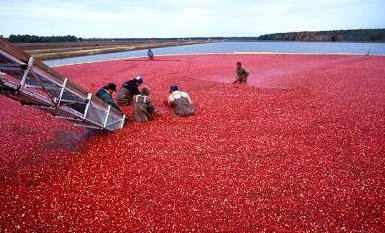
 NEWS HIGHLIGHT
NEWS HIGHLIGHT
Extending the life of fresh cranberries
The good news about cranberries is spreading, resulting in growing
consumer demand for fresh cranberries and cranberry products. This demand has led to increased interest in finding ways to extend the shelf life of the popular fruit.
October 21, 2008, Kentville, N.S. — The good news about cranberries is spreading, resulting in growing consumer demand for fresh cranberries and cranberry products. This demand has led to increased interest in finding ways to extend the shelf life of the popular fruit.
 Setting out to determine the optimum conditions for storing fresh cranberries, Dr. Charles F. Forney, a research scientist in postharvest physiology at the Atlantic Food and Horticulture Research Centre in Nova Scotia, conducted a study of fresh cranberries and their postharvest life. Dr. Forney’s study was published recently in the April 2008 issue of HortScience.
Setting out to determine the optimum conditions for storing fresh cranberries, Dr. Charles F. Forney, a research scientist in postharvest physiology at the Atlantic Food and Horticulture Research Centre in Nova Scotia, conducted a study of fresh cranberries and their postharvest life. Dr. Forney’s study was published recently in the April 2008 issue of HortScience.
The research study was conducted over three seasons to determine the relationship of temperature and humidity on fresh cranberries. The objectives of the study were to determine how temperature and relative humidity affect cranberry storage life, and to assess the “chilling sensitivity” of cranberries.
To obtain vital information about storage conditions, cranberries were harvested from four commercial bogs and stored at temperatures ranging from 0 to 10°C in combination with relative humidity ranging from 75 to 98 per cent.
“Fruit were stored under these conditions for up to six months and were evaluated monthly for marketability, decay, physiological breakdown, weight loss, and firmness immediately after removal and after an additional week at 20°C,” said Dr. Forney. “The percentage of marketable fruit declined substantially over time in all storage conditions, with 41 to 57 per cent becoming unmarketable after two months as a result of both decay and physiological breakdown.”
Dr. Forney concluded that relative humidity had a greater effect on fruit storage life than temperature. After five months, the amount of marketable fruit stored in high (98 per cent) and medium (88 per cent) relative humidity was 71 and 31 per cent less than that stored in low (75 to 82 per cent).
“Results suggest that cranberry fruit should be stored at 0 to 7°C and 75 to 82 per cent relative humidity to retain marketable fruit,” he remarked.
The study outcomes can offer cranberry growers and processors important information about methods for prolonging freshness and marketability of fresh cranberries, and consumers will ultimately see the benefits of fresher, wholesome, antioxidant-rich berries.
Print this page